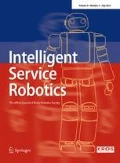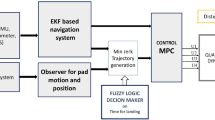Abstract
In this paper, we present an approach which enables a low-cost quadrocopter to fly various trajectories autonomously. Artificial landmarks are used for pose estimation, and a fuzzy controller is utilized to generate steering commands. The presented system can navigate a low-cost quadrocopter along a predefined path without the need for any additional external sensors. In addition to a full description of our system, we also introduce our software package for Robot Operating System, which allows the robotics community to experiment with proposed mapping algorithm.













Similar content being viewed by others
References
Bry A et al (2015) Aggressive flight of fixed-wing and quadrotor aircraft in dense indoor environments. The International Journal of Robotics Research. 34(7):969–1002. doi:10.1177/0278364914558129
Hehn M, RaffaelloD’A (2012) Real-time trajectory generation for interception maneuvers with quadrocopters. In: IEEE/RSJ International Conference on Intelligent Robots and Systems (IROS); 7. - 12.10.2012; Vilamoura. IEEE; 2012. p. 4979-4984. DOI:10.1109/IROS.2012.6386093
M. Q. Lindsey M Q, Mellinger D, Kumar V (2012) Construction of cubic structures with quadrotor teams. In: Proceedings of Robotics: Science and Systems (RSS); Los Angeles, USA. MIT Press; 2012. p. 177-184
Grzonka S, Grisetti G, Burgard W (2009) Towards a navigation system for autonomous indoor flying. In: IEEE International Conference on Robotics and Automation (ICRA); 12. - 17.5.2009; Kobe. IEEE; 2009. p. 2878-2883. DOI:10.1109/ROBOT.2009.5152446
Ascending technologies [Internet]. 2016 . Available from: http://www.asctec.de/
Krishnakumar R, Rasheed AM, Kumar KS, \(>>\) ””, October 21, (2015) Enhanced hover control of quad tilt frame UAV under windy conditions. International Journal of Advanced Robotic Systems. 2015:1–14. doi:10.5772/61231
Krajník T, Vonásek V, Fišer D, Faigl J (2011) AR-Drone as a Platform for Robotic Research and Education. Communications in Computer and Information Science. 161:172–186
Rullan-Lara JL, Sanahuja G, Lozano R, Salazar S, Garcia-Hernandez R, Ruz-Hernandez JA (2013) Indoor Localization of a Quadrotor Based on WSN: A Real-Time Application. International Journal of Advanced Robotic Systems. 10:48. doi:10.5772/53748
Kim SJ, Kim BK (2012) Dynamic Ultrasonic Hybrid Localization System for Indoor Mobile Robots. IEEE Transactions on Industrial Electronics. 60(20):4562–4573. doi:10.1109/TIE.2012.2216235
Droeschel D, Schreiber M, Behnke S (2013) “.” UAV-g 8/2013. (2013). Omnidirectional perception for Lightweight UAVs using a continuously rotating 3D laser scanner. In: UAV-g 8/2013; 4. – 6.9. 2013; Rostock, Germany. The international archives of the photogrammetry, remote sensing and spatial information sciences, XL-1 W 2; 2013. p. 107-112. DOI:10.5194/isprsarchives-XL-1-W2-107-2013
Engel J, Sturm J, Cremers D (2012) Accurate figure flying with a quadrocopter using onboard visual and inertial sensing. In: Workshop on Visual Control of Mobile Robots /ViCoMoR at the IEEE/RJS International Conference of Inteligent Robots and Sytems (IROS); 7.-12.10.2012; Vilamoura, Portugal. IEEE; 2012
Zingg S, Scaramuzza D, Weiss S, Siegwart R (2010) MAV navigation through indoor corridors using optical flow. In: Robotics and Automation; 3-7 May 2010; Anchorage, AK. 2010. p. 3361 - 3368. DOI:10.1109/ROBOT.2010.5509777
Eberli D et al (2011) Vision based position control for MAVs using one single circular landmark. Journal of Intelligent & Robotic Systems. 61(1):495–512. doi:10.1007/s10846-010-9494-8
Lamberti F et al (2013) Mixed marker-based/marker-less visual odometry system for mobile robots. International Journal of Advanced Robotic Systems. 10(1):1–11. doi:10.5772/56577
Hartmann P, Ben C, Moormann D (2014) Naviagation for Vertical Precision Landing Based on Optical Tracking of a Spatial Retroreflective Marker Array. In: 29th Congress of the International Council of the Aeronautical Sciences; 7-12 September; St. Petersburg, Russia. 2014. p. pp. 1-8
Muñoz-Salinas, Rafael, et al (2016) “Mapping and Localization from Planar Markers.” arXiv preprint arXiv:1606.00151
Garrido-Jurado S et al (2014) Automatic generation and detection of highly reliable fiducial markers under occlusion. Journal Pattern Recognition. 47(6):2280–2292. doi:10.1016/j.patcog.2014.01.005
Kendoul F (2012) Survey of advances in guidance, navigation, and control of unmanned rotorcraft systems. Journal of Field Robotics. 29(2):315–378. doi:10.1002/rob.20414
Derafa L, Madani T, Benallegue A (2006) Dynamic Modelling and Experimental Identification of Four Rotors Helicopter Parameters. In: Proceedings of the IEEE International Conference on Industrial Technology; 15.-17.12.2006; Mumbai, India. IEEE; 2006. p. 1834-1839. DOI:10.1109/ICIT.2006.372515
OstafewCh J, Schoellig AP, Barfoot TD (2014) Learning-based nonlinear model predictive control to improve vision-based mobile robot path-tracking in challenging outdoor environments. In: IEEE International Conference on Robotics and Automation (ICRA); 31.5. - 7.6.2014; Hong Kong. IEEE; 2014. p. 4029-4036. DOI:10.1109/ICRA.2014.6907444
Gautam D, Ha Ch (2013) Control of a quadrotor using a smart self-tuning fuzzy PID controller. International Journal of Advanced Robotic Systems. 10:1–9. doi:10.5772/5691
Poundsa P, Mahonyb R, Corkec P (2010) Modelling and control of a large quadrotor robot. Control Engineering Practice. 18(7):691–699. doi:10.1016/j.conengprac.2010.02.008
Mamdani EH, Assilian S (1975) An experiment in linguistic synthesis with a fuzzy logic controller. International Journal of Man-Machine Studies. 7(1):1–13
Szlachetko B, Lower M, Nguyen NT, Hoang K, Jȩdrzejowicz P (2012) On Quadrotor Navigation Using Fuzzy Logic Regulators, Computational Collective Intelligence. Technologies and Applications: 4th International Conference, ICCCI 2012, Ho Chi Minh City, Vietnam, November 28–30, 2012. Proceedings, Part I
Indrawati V, Prayitno A, Kusuma T A (2015) Waypoint Navigation of AR.Drone Quadrotor Using Fuzzy Logic Controller, TELKOMNIKA, Vol.13, No.3, September 2015, pp. \(930\sim 939\)
Acknowledgements
The authors wish to thank the project VEGA 459 1/0464/15 for its support. This work was supported by the Slovak Research and Development Agency under the contract No. APVV-15-0750.
Author information
Authors and Affiliations
Corresponding author
Rights and permissions
About this article
Cite this article
Bacik, J., Durovsky, F., Fedor, P. et al. Autonomous flying with quadrocopter using fuzzy control and ArUco markers. Intel Serv Robotics 10, 185–194 (2017). https://doi.org/10.1007/s11370-017-0219-8
Received:
Accepted:
Published:
Issue Date:
DOI: https://doi.org/10.1007/s11370-017-0219-8




